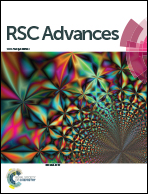Synthesis of novel inhibitors of β-glucuronidase based on the benzothiazole skeleton and their molecular docking studies†
Abstract
A series of benzothiazole based oxadiazole analogs 1–20 was synthesized by reacting intermediate sulfite adducts with 2-aminothiophenol and refluxing in DMF for 12 h to afford ester analog I which, on further refluxing in methanolic hydrazine hydrate solution, afforded compound II. Compound II was then condensed with different aromatic carboxylic acids in POCl3 to synthesize novel benzothiazole based oxadiaxole derivatives 1–20 in good yields. All compounds were screened for β-glucuronidase inhibitory potential. Compounds 7, 14, 8 and 17 were found to be the most active analogs among the series with micromolar activities (IC50 = 2.16, 4.38, 7.20 and 8.56 μM, respectively). While compounds 5, 10, 18, 16, 1, 2, 15, 11, and 20 showed moderate activity with (IC50 values ranging between 14.12–75.14 μM), whereas compounds 3, 12, 13, and 19 were found to be inactive. Further studies showed that they do not possess any cytotoxic properties. Molecular docking studies were done to reveal the binding modes of the synthetic benzothiazole derivatives 1–20 targeting the active site of β-glucuronidase (PDB code: 1BHG).


 Please wait while we load your content...
Please wait while we load your content...